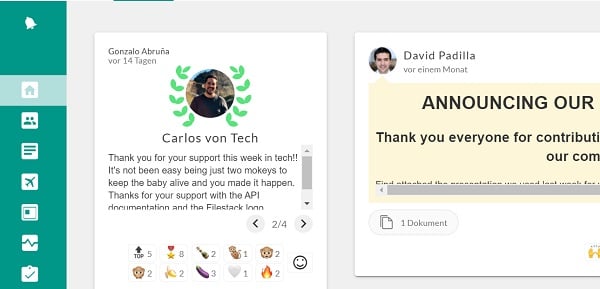8 ways to build trust in remote teams

“Trust is good, but control is better.” This old Russian proverb unfortunately doesn’t work so well with remote teams. Control only causes unnecessary stress, whereas trust creates a relationship at eye level. Our tips will help you create a solid basis for any successful remote cooperation.
COVID-19 forced us to combine the two most important areas of our life - private and professional - into one remote office practically overnight. Many companies are struggling to establish new work processes and routines. After all, not everyone wants to check on emails at the kitchen table or show their colleagues their home furnishings in a Zoom meeting.
The transition from working in a fixed office every day to working independently requires employees and employers to work on building trust in remote teams. This means that managers are having to take a leap of faith. After all, control and stress are motivation killers par excellence.
Trusting in employees, their work performance and motivation is the magic formula here. But how can managers develop trust in their remote employees if it’s impossible to check when and how much work is being done?
We show HR managers and supervisors how they can track employee performance without the pressure and stress, and create an atmosphere of trust, recognition and appreciation. Generally, a workplace where employees are happy to give one hundred percent.
What’s a high-trust culture?
A fully working high-trust culture is the key to your remote work strategy. Because trust and fairness are based on mutual respect; they nurture collaboration and creativity. Who doesn’t love to be treated like the grown-up professional they really are? We know we do! Managers can instil trust in their organisation through their words, actions, budgets, and stories. Some of the signs of this are:
- Values such as transparency, fairness, kindness and generosity are being promoted in your company.
- Your employees are treated with respect.
- Employees are encouraged to make their own decisions and are trusted to deliver.
- There are regular feedback rounds.
- The workplace is perceived as being fundamentally fair.
- Leaders are leading by example.
- There’s a strong sense of camaraderie and collaboration.
How to build trust when your teams are working from home
Old habits die hard, so it’s easier to prevent them than to break them. Good HR managers don't let things get that far and work proactively on confidence-building measures. Important methods for building trust are:
1. Promote communication
We can't stress this enough, but communication is by far the most important component of team collaboration. This includes not only the professional exchange of goals, objectives and projects, but also on a personal level.
For example, joint coffee breaks via video conference help people to get to know each other in a relaxed and approachable manner. We know this principle from our private lives: the better we get to know people, the more we trust each other. This also helps employees feel less lonely while working from home.
2. The gift of freedom
Many managers are afraid of losing control over their remote employees. After all, they can't check in on every single employee at home to see if they really are working or taking care of their laundry.
As tempting as it may be, managers should resist the urge to take control, and trust in employees to meet important deadlines. Thinking about goals in the long-term and seeing the big picture helps to establish a team atmosphere of trust and appreciation.
3. Appreciation and praise
Regular feedback or brief praise can work wonders for employee motivation, especially when working from home. Once you have experienced how employees blossom in the company through praise and appreciation, or even public recognition, you’ll be sure to keep it in your toolbox in future.
While working remotely, appreciation for productive work is twice as important, as the small nuances of personal conversations are eliminated. That’s why we use our Kenjo Shout-out feature, to give our colleagues a chance to share how much we love each other’s work and make sure everyone else sees it too!
 Kenjo Shout-out Feature
Kenjo Shout-out Feature
4. Clearly defined goals and rules
Clear communicating rules help the team to work more efficiently. The quickest way to build trust is to have a common and clear objective that inspires them to do their best. With our goals and OKRs feature, we help companies to define clear goals and objectives for remote workers to set them up for success.
In relation to OKR goals, your expectations, deadlines, and results should be communicated, and progress recorded. At the same time, supervisors and employees should mutually agree whether a weekly 1:1 catch-up is sufficient to track the project’s development or whether they need to be more, or less frequent.
If you’d like to learn more about the key stages in performance management, check out our performance management guide.
5. Areas of responsibility
Just like the goal-setting process, clearly defined areas of responsibility help to track how a project is evolving. Here, it also becomes clear whether, and under what circumstances, employees fall short of expectations. This enables managers to react quickly and, for example, organise individual coaching or training.
No team member should need to feel like they’re working alone on a project while colleagues give minimal input and shirk responsibility. This can be quickly remedied by making a clear agreement on the different areas of responsibility.
6 Regular contact
Regular contact compels team members to meet deadlines. Irrespective of what kind of check-ins, joint status updates or collaboration you hold within a project management platform, regular communication stimulates motivation and accountability. And it gives team leaders a positive sensation that the project is progressing.
Ever wondered how we do this at Kenjo? Well, we’re glad you asked…😀 We have weekly manager-employee meetings as well as daily 1:1s, team dailies. We also have a monthly all-hands meeting where every department presents what they’re working on, what they achieved or what stopped them in doing so. This is also the perfect opportunity to officially welcome new team members and celebrate any achievements. Since our offices are spread across Madrid and Berlin, this is an awesome way of getting together and seeing what everyone is working on.
7. Promoting strengths
Every member of the team has unique strengths that ideally complement each other. This is exactly why they were hired in the first place.
We should clearly communicate each team member’s strengths to new recruits from the start, during the remote onboarding process. This is also a great opportunity to explain how employees will complement each other so that they can work together successfully.
8. Use automated tools
It’s easy to get lost with so many tools and applications, from Trello, Google Docs, Jira, Asana, GitHub, to name a few. By the way, you can find our tips for the best remote working tools in our blog.
Automated workflows help to keep track of things without the need to micromanage employees and make endless phone calls afterwards. For effective remote working, automated tools are a must.
Remote teams need an appropriate infrastructure so that they can concentrate fully on achieving their goals. Shared folders, documents etc. play a key role in this.

Trust and transparency instead of control
Transparency is hugely important for every company. But this is especially true with remote working; there is no way around a transparent work process.
When many employees work together from different locations, information is often inadvertently withheld or team colleagues talk at cross purposes. Managers sometimes act impulsively when this happens, reverting to outdated working methods of control and micro-management. But behaving this way is like going back to the stone age and often has the opposite effect when working remotely.
In a remote work environment, focusing on results works much better than constant monitoring and questioning. We’re talking about trust in the end product and achieving KPIs, instead of just being present at the workplace office-style.
We believe that the value of remote work lies precisely in that trust. Having the confidence that employees can manage their own time and responsibilities independently, and with a clear goal in mind.
At the end of the day, employees are held accountable for their actual performance and not for the hours they work. That’s the kind of workplace revolution we’re talking about!
Ultimately, a culture of trust helps to hold employees accountable for their work. After all, trust among colleagues is the foundation for almost every aspect of a successful business, especially when it comes to managing a company.


